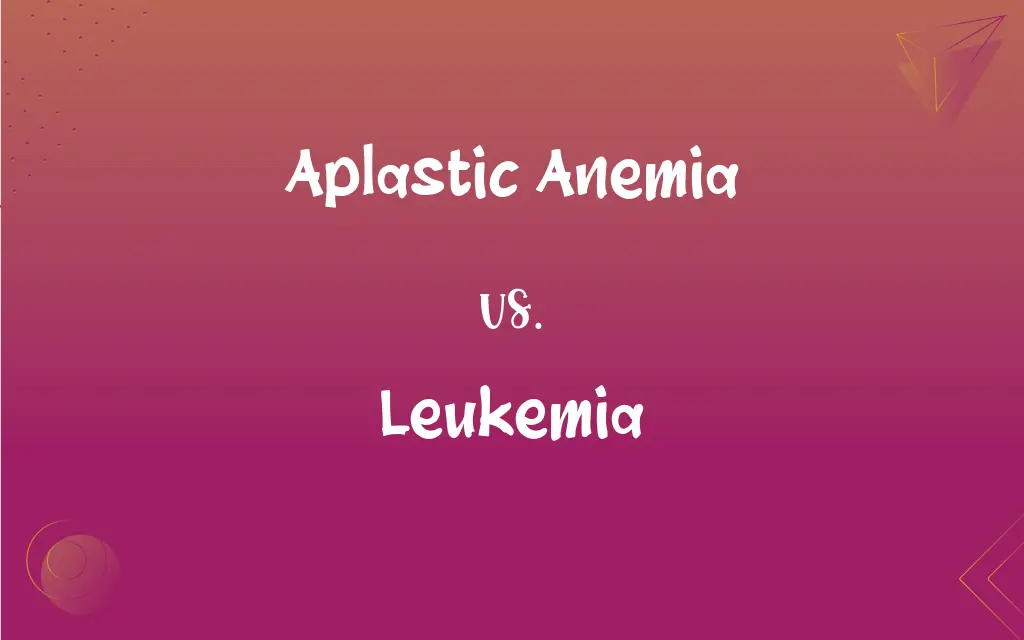Aplastic Anemia vs. Leukemia: What's the Difference?
Edited by Aimie Carlson || By Janet White || Published on February 13, 2024
Aplastic anemia is a bone marrow failure disorder causing reduced blood cell production, while leukemia is a cancer of blood-forming tissues, leading to excessive white blood cell production.

Key Differences
Aplastic anemia is characterized by the bone marrow's inability to produce sufficient blood cells, including red and white blood cells and platelets. Leukemia, in contrast, is a form of blood cancer where the bone marrow produces abnormal white blood cells in excessive quantities.
In aplastic anemia, patients suffer from symptoms related to low blood cell counts, such as fatigue, increased susceptibility to infections, and bleeding disorders. In leukemia, symptoms often include fatigue, frequent infections, and easy bruising, but are caused by the proliferation of abnormal white blood cells.
The cause of aplastic anemia can be idiopathic, or due to factors like toxins, radiation, or certain medications. Leukemia's etiology includes genetic and environmental factors, such as exposure to certain chemicals or radiation.
Treatment for aplastic anemia may involve blood transfusions, bone marrow stimulants, or in severe cases, bone marrow transplantation. Leukemia treatments vary depending on the type but often include chemotherapy, radiation therapy, targeted therapy, and sometimes bone marrow transplant.
The prognosis of aplastic anemia varies based on severity and response to treatment, with some cases being life-threatening. Leukemia's prognosis depends on the type and stage of cancer, patient's age, and response to treatment, with some forms being highly treatable.
ADVERTISEMENT
Comparison Chart
Definition
Bone marrow failure, reduced blood cell production
Cancer of blood-forming tissues, excessive white blood cell production
Symptoms
Fatigue, infections, bleeding disorders
Fatigue, frequent infections, bruising
Causes
Idiopathic, toxins, radiation
Genetic, environmental factors
Treatment
Blood transfusions, marrow stimulants, transplant
Chemotherapy, radiation, targeted therapy, transplant
Prognosis
Varies, can be life-threatening
Depends on type and stage, varies
ADVERTISEMENT
Aplastic Anemia and Leukemia Definitions
Aplastic Anemia
Aplastic anemia is a condition of bone marrow failure.
He was diagnosed with aplastic anemia after showing symptoms of fatigue and bruising.
Leukemia
Leukemia is a type of blood cancer affecting white blood cells.
Leukemia patients often present with an abnormal white blood cell count.
Aplastic Anemia
Aplastic anemia's prognosis depends on its severity.
Early diagnosis and treatment improve aplastic anemia's prognosis.
Leukemia
Leukemia treatment often involves chemotherapy.
Chemotherapy is a common treatment approach for many types of leukemia.
Aplastic Anemia
Aplastic anemia results in reduced blood cell production.
Aplastic anemia patients often require regular blood transfusions.
Leukemia
Leukemia's prognosis varies based on type and stage.
Early-stage leukemia has a better prognosis with appropriate treatment.
Aplastic Anemia
Aplastic anemia can be caused by external factors like radiation.
Her aplastic anemia was linked to prolonged exposure to certain chemicals.
Leukemia
Leukemia leads to the production of abnormal blood cells.
The bone marrow in leukemia produces excessive, dysfunctional blood cells.
Aplastic Anemia
Aplastic anemia treatment may include bone marrow transplant.
A bone marrow transplant can be a potential cure for severe aplastic anemia.
Leukemia
Leukemia has various forms, including acute and chronic types.
Acute leukemia develops rapidly and requires immediate treatment.
Leukemia
Any of various acute or chronic neoplastic diseases of the bone marrow in which unrestrained proliferation of white blood cells occurs, usually accompanied by anemia, impaired blood clotting, and enlargement of the lymph nodes, liver, and spleen.
Leukemia
Any of a class of types of cancer affecting the blood cells, especially the white blood cells (usually with massive leukocytosis), and the blood cell–forming (hematopoietic) tissues.
The subjects suffered from lymphoblastic and myeloid leukemias.
Leukemia
Malignant neoplasm of blood-forming tissues; characterized by abnormal proliferation of leukocytes; one of the four major types of cancer
FAQs
Are there different types of leukemia?
Yes, including acute and chronic forms.
What causes aplastic anemia?
Causes include idiopathic factors, toxins, and radiation.
How is aplastic anemia diagnosed?
Through blood tests and bone marrow biopsy.
Can aplastic anemia be inherited?
Some forms can be hereditary, but most cases are acquired.
What lifestyle changes help manage aplastic anemia?
Avoiding toxic exposures and maintaining a healthy diet.
What age group is most affected by leukemia?
It can occur at any age, but some types are more common in certain age groups.
Can aplastic anemia turn into leukemia?
Rarely, but some patients may develop a related cancer.
Can leukemia be cured?
Some types can be cured or managed effectively with treatment.
Is leukemia hereditary?
While not typically hereditary, some genetic factors increase risk.
What is leukemia?
Leukemia is a cancer affecting blood-forming tissues.
Is aplastic anemia a form of cancer?
No, it's a bone marrow failure disorder.
How is leukemia treated?
Treatments include chemotherapy, radiation, and targeted therapy.
Does aplastic anemia affect a specific type of blood cell?
It affects all types: red cells, white cells, and platelets.
What are common symptoms of leukemia?
Symptoms include fatigue, frequent infections, and easy bruising.
Can aplastic anemia be acute or chronic?
It's usually chronic but can have acute presentations.
How long is treatment for leukemia?
Treatment duration varies based on type and patient response.
What is the survival rate for leukemia?
It varies widely based on type, stage, and individual factors.
Is there a known prevention for aplastic anemia?
Avoiding known risk factors can reduce the risk, but not all cases are preventable.
Are blood transfusions common in aplastic anemia treatment?
Yes, they're often necessary to manage symptoms.
Does leukemia affect children and adults differently?
Yes, the types and responses to treatment can vary by age.
About Author
Written by
Janet WhiteJanet White has been an esteemed writer and blogger for Difference Wiki. Holding a Master's degree in Science and Medical Journalism from the prestigious Boston University, she has consistently demonstrated her expertise and passion for her field. When she's not immersed in her work, Janet relishes her time exercising, delving into a good book, and cherishing moments with friends and family.
Edited by
Aimie CarlsonAimie Carlson, holding a master's degree in English literature, is a fervent English language enthusiast. She lends her writing talents to Difference Wiki, a prominent website that specializes in comparisons, offering readers insightful analyses that both captivate and inform.






































































